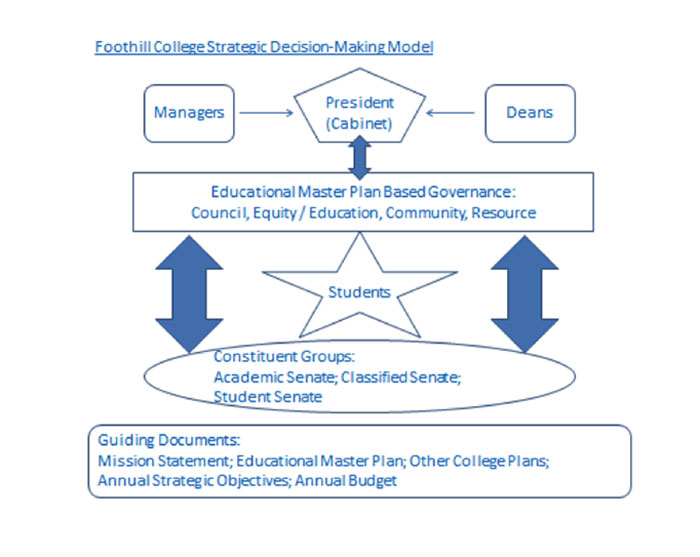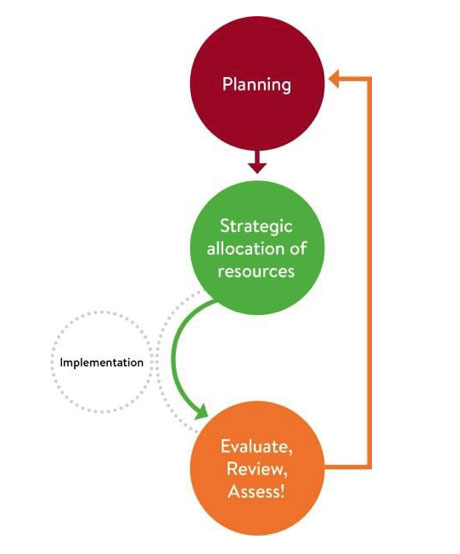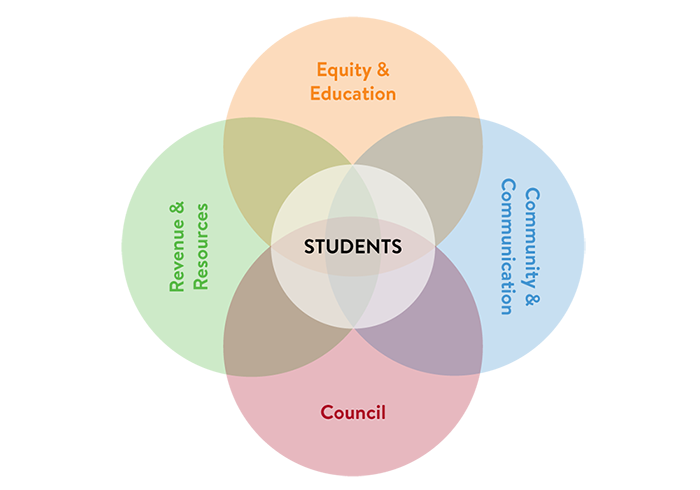
Governance Handbook

Governance Handbook 2020-2021
Revised September 2020
Table of Contents
- Introduction
- The Case for Change
- Governance Indicators of Success
- Principles and Role of Governance at Foothill College
- The Educational Master Plan Model of Governance
- Committee Structure and Logistics
- Governance Group Descriptions
- Governance Committee Meeting Schedule
- Appendices
- Annual Supplemental Documents
Introduction
A successful organization strives to engage all employees in achieving its mission. At Foothill Collegethis means bringing together experts withdiverseideas and perspectives to help students achieve their goals. While ultimately the President is responsible to the Chancellor, the Board of Trustees and the taxpayers for decision-making, the President has the opportunity to take counsel from a range of experts to inform those decisions. This process of sharing perspectives and input is called participatory governance. The process informs decision-making and results in engagement important for achieving the college mission. Governance empowers individuals from across the organization to share their voice about important topics facing the college. Given the importance of participatory governance, it is critical that we continually examine our processes and make changes that will improve its effectiveness.
The Case for Change
The former governance structure dates back to 2009-10. There were four mission- based workgroups with tri-chairs that served as representatives on the Planning and Resource Council (PaRC). The structure also included a Program Review Committee and an Operations and Planning Committee. Over the years, additional groups were created, such as the technology taskforce, the professional development committee, and the assessment taskforce.
The Governance Handbook was last updated in December 2012. The Handbook did not fully articulate PaRC members’ responsibilities regarding representation and communication. Theconnection between committees that had been created since2012 and their representation on PaRC was not always explicit. Over the years, the annual governance survey often identified the need for improved communication of governance work. In addition:
- The Educational Master Plan discussion in spring 2015 identified Governance as a strategic priority, culminating with the goal to “expand participation from all constituencies in shared governance” adopted in fall
- A series of planning / governance structure meetings were held in spring 2016 to discuss the results of a governance structure
- The Accreditation Leadership Summit in fall 2016 identified governance as a possible Quality Focused Essay topic, which was later adopted as part of the self- evaluation in May
- A Governance Retreat in September 2017 discussed the need for a new governance system that fostered engagement around strategic objectives rather than operational
- In 2017-18 the Governance Leadership Council began by assessing the strengths and weaknesses of the current model and the need for
Governance Change TimelineThe governance review timeline is highlighted below.
|
Proposed Governance Council Indicators of Success
The following factors have been expressed as indicators of a successful governance system:
- All members have the opportunity to participate in council discussion.
- Council input is used to help shape the direction of college
- A variety of opinions on council agenda topics were
- The council fosters an environment where discussion topics could be viewed from different
- All council members have an opportunity to influence the deliberative process of making a recommendation to the
- Sufficient information / documents are shared with councilmembers so as to provide background on discussion topics
Principles and Role of Governance
Governance involves the opportunity for campus constituent groups to engage in discussions over the future direction of the college. The Accreditation Commission for Community and Junior Colleges (ACCJC) requires in Standard IV.A.5 that the “institution ensures the appropriate consideration of relevant perspectives”:
IV.A.5 Through its system of board and institutional governance, the institution ensures the appropriate consideration of relevant perspectives; decision making aligned with expertise and responsibility; and timely action on institutional plans, policies, curricular change, and other key considerations.
In addition, education code also requires that various “opinions are given every reasonable consideration” in decision-making: Education Code-70902
Establish procedures that are consistent with minimum standards established by the board of governors to ensure faculty, staff, and students the opportunity to express their opinions at the campus level, to ensure that these opinions are given every reasonable consideration, to ensure the right to participate effectively in district and college governance, and to ensure the right of academic senates to assume primary responsibility for making recommendations in the areas of curriculum and academic standards.
Foothill College Strategic-Decision Making ModelGovernance is an important part of the decision-making process at Foothill College and involves administration and the constituent groups, with students at the center.
Administration includes Managers and Deans reporting to President's Cabinet Educational Master Plan-Based Governance Councils include Advisory; Equity & Education; Community & Communication; and Revenue & Resources. A fifth Return to Campus Council was added in 2021. Constituent Groups include Academic Senate, Classified Senate, and Student ASFC Council. Guiding Documents include mission statement; educational master plan; other college plans; annual strategic objectives; and annual budget. |
The principles Governance adopted by the Governance Redesign Leadership Council include:
- Governance should allow participants to feel engaged and
- Governance should be fun – allowing us to brainstorm ideas
The Governance Council proposed that the focus of the governance councils will be on the assessment of progress on the Educational Master Plan and related college plans:
- Planning
- Strategic allocation of resources [Implementation]
- Evaluate / review / assess institutional effectiveness (I.E.)
- Re-plan – identify changes to the plan
The cycle of planning is depicted in the image below – the Role of Governance.
Governance may also involve the opportunity to share information and get feedback on issues facing the college.
Role of GovernancePlanning • Strategic Allocation of Resources • Implementation • Evaluate, Review, Assess
|
Critical Recommendation Items for Governance Councils
The governance councils will each have responsibility for the following planning functions:
- Assess progress and changes to institutional plans
- Assess progress on Educational Master Plan goal activities
- Program review, creation, discontinuance
- Strategic objectives
- Resource prioritization
- Evaluate governance processes
The Educational Master Plan Model of Governance
The new governance model will follow the Educational Master Plan goals and will include a council for each goal area (Equity and Education, Community and Communication, Revenue and Resources), as well as a committee for overall college planning (Advisory). Therefore, there will be four independent governance councils. The Academic and Classified Senates will continue to operate, as well as subcommittees of the Academic Senate such as the Curriculum Committee. Operational committees (such as financial aid scholarship readers) will continue to operate.
Foothill College Governance Model
|
Committee Structure and Logistics
Operation of Councils
Council operation will include the following:
- Each council will have 12 members – 4 Faculty, 3 Classified Staff, 3 Students, and 2 Administrators. Members will be on only one
- Each council will be assigned a recorder
- Each council will be assigned ex-officio members to support the work of the committee.
- Recommendations from the councils must be transmitted in written memorandum. The President will write back to the council outlining the decisions made.
- Councils will have a trained facilitator assigned by the President who is a Foothill employee but not a member
- Each of the four councils will meet once each month (please see the 2020/21 Governance schedule). Each council may decide to schedule extra meetings as necessary.
Communication
It is expected that representatives will report back to their respective constituent groups after each meeting. In addition, agendas and minutes will be available electronically in a timely fashion before and after the meetings. Monthly facilitator meetings will provide another avenue for communication of information between committees. The college will continue to email a monthly newsletter on committee work.
The Role of Part-time Faculty
Part-time faculty members represent a significant percentage of the Foothill community. Their contribution to student success is crucial in attaining the college mission and Educational Master Plan goals. Therefore, part-time faculty members represent a critical voice in college governance and every effort should be made to include members on committees.
Part-time faculty will receive pay for service on the governance councils.
Council Logistics
The information below outlines the details of council logistics and operations.
Councils
The new governance model will follow the Educational Master Plan goals and will include a council for each goal area, presently: Equity and Education, Community and Communications, Revenue and Resources, as well as a council for overall college planning (Advisory). Therefore, there will be 4 independent governance committees.
The Academic and Classified Senates will continue to operate, as well as subcommittees of the Academic Senate such as Curriculum. Operational committees (such as financial aid scholarship readers) will continue to operate.
Membership
Councils will have 12 members in total with four members from Faculty, three from Classified Staff, three from Students, and two from Managers. A member can only serve on one council.
Recommendations
Each committee will act independently to set the calendar and agenda. Each council can make recommendations directly to the President. All recommendations will be made in writing following a standard template. It is the tri-chairs responsibility to draft all memos. Facilitators and Recorders can support the tri-chairs in this role, as required.
Schedule
Council meetings will be scheduled for Friday mornings and afternoons. Each Council will meet once each month and extra meetings should be coordinated such that no two council meetings take place at the same time.
Appointments
It will be up to the Senates (Academic, Classified, AFSC) and the President (for administrators) to make decisions on appointments to the councils, including Chairs, terms and term limits. The Senates may want to consider staggering the terms, but it is up them. In the future, the Senates may also wish to select Chairs from members whom have already served on the council to foster continuity over time.
Facilitators and Recorders
Each council will be assigned a facilitator and a recorder. Facilitators and recorders will be Foothill employees, but not members of the council (they will not vote, they will not be a tri-chair) and will be appointed by the President and assigned to a council for a whole year. Facilitators and recorders collaborate with the chairs in agenda setting.
Facilitators will prepare and distribute the agenda (using a standard template) in sufficient time to meet Brown Act requirements. During the meeting, the facilitator will be responsible for encouraging participation from all council members, calling on members to speak (so asto avoid members talking over each other), keeping the discussion connected to the agenda item, and keeping the discussion within the meeting time. The facilitator will summarize actions prior to voting, and will allow adequate time for additional discussion necessary prior to having the council vote on an action to be taken. There may be a monthly meeting of facilitators to share information across councils (this will also provide a backup just in case a facilitator can’t make a meeting).
Recorders will note topics of discussion, points made, agreement/disagreement on points made, in reasonable detail so that upon review community members could easily understand what was discussed at a meeting. Recorders are responsible for taking and posting / sharing the draft minutes of the meeting within a week of the meeting using a standard template.
Subcommittees / Study Groups / Taskforces
There will be no standing subcommittees. However, the creation of a study group for a council may be deemed necessary to aid in carrying out the council’s charge.
Councils may appoint members to one or more study groups that will meet for a defined period of time and present their findings and recommendations to the council.
The study group will be chaired by a member of the council. The study group could be made up of some of the members of the council or the council could appoint an entirely different group of members from the Foothill community. Where possible the council will consider its needs during the September Governance Summit and make an announcement at that meeting. This does not preclude the announcement of a new study group mid-year.
The councils have the authority to commission study groups/taskforces to take on specific work that the councils feel requires concerted attention. The makeup of each study group/taskforce should be stipulated by the council, but should involve all campus constituencies (faculty, staff, students, administrators) and members should be appointed by the governing bodies of those constituencies.
Representation
Council members are expected to represent the constituent groups that appointed them. It is expected that the tri-chair will report back to their respective Senates in writing / or verbally after each meeting.
Council Communication
Each council may act to share information or a recommendation to another council if they believe it would be important for another council to consider, given the charge.
The council will do so in writing using a standard template.
A governance webpage will include up-to-date information on each council. Representatives will report totheir constituent groups after each meeting. A campuswide email blog (Foothill College Fusion) will publish monthly updates.
Attendance
Attendance in-person is encouraged.
All meetings are open to the Foothill College community and everyone is welcome and encouraged to sit in on and participate in council meetings. All meetings will be broadcast via video conferencing. The meetings will not be recorded.
Chairs
Each council will have a tri-chair appointed by the Faculty, Classified Staff, and President. Given the demands on their time, students will not serve as chair.
Agenda Setting
During the Governance Summit, the councils will develop a draft calendar for the year – the Sample Agenda Topics in Supplement 2 are examples. An agenda setting meeting that includes the chairs, facilitators, and recorders will take place before each committee meeting. The agenda will include needed supporting materials. It will be the responsibility of the administrative tri-chair to contact the ex-official members so that materials can be prepared to support the agenda item. The materials will be prepared and presented by ex- officio members or other employees with expertise in that area.
Governance Group Descriptions
Each committee will have responsibility over specific topic areas related to the Educational Master Plan. It is recognized that some topic areas may overlap and new topic areas will emerge -- each council can address the topic and communicate their recommendation to the other councils.
Council Charge: The Charge of the councils is to monitor goals related to the Educational Master Plan, as well as supporting plans, including the strategic allocation of resources to achieve plan goals. The Council has responsibility for overall college planning.
Council Topic Areas
Advisory Council
Strategic objectives, college-wide planning, college resource allocation, prioritization
of new full-time faculty hires (all funds), accreditation, program approval and discontinuance
.
Equity and Education Council
Instruction, equity, basic skills, program Review, 3SP, workforce, transfer, assessment, online enrollment, dual enrollment
Community and Communication Council
Professional development, community education, service leadership, institutional learning outcomes, alumni, governance, communication
Revenue and Resources Council
Budget, technology, sustainability, facilities
Governance Council Meeting Schedule
Governance councils (including Study Groups) will meet on Fridays. Please see the 2020/21 schedule in your Governance handbook for all scheduled council meetings.
Councils can decide if they want to meet more than once monthly or when to schedule a makeup meeting. Every effort should be made to ensure that all extra meetings should be scheduled at 11:00 AM or 1:30 PM on a Friday that does not already have a scheduled council meeting. If this is not possible, the tri-chairs should contact the three other councils to confirm that they will be holding a 9:00 AM Friday meeting.
For 2020/21, Governance meetings are scheduled on the first and third Fridays of each month to allow for staff to have more flexible schedules on the second and fourth Fridays.
Go to Next
Governance Home | Handbook | Appendices | Supplemental Documents

Questions?
Please contact me!
Veronica Casas, President's Office
650.949.7200
casashernandezveronica@fhda.edu
Administration Building 1900



 Governance involves discussions that are about setting college goals and plans. Governance
involves making suggestions and recommendations, with the President responsible for
final decision-making.
Governance involves discussions that are about setting college goals and plans. Governance
involves making suggestions and recommendations, with the President responsible for
final decision-making.